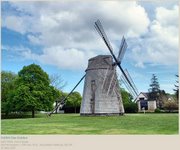Are you sick of the puns yet? I promise, no more eye puns. I'm back, though, and the eye surgery went well. My left eye now sees better than it has since I was about 7 or so, when I first started wearing glasses. Right eye still gets to wear a contact, and reading glasses are still needed, but... It's nice to see again, and nice to not have the headache that has plagued me for the last 5 months.
The eye surgery was... Interesting. I spent nearly two hours in prep, getting an antibiotic/numbing eye ointment that was like apple jelly applied twice, and then, just before the surgery, a intravenous injection of something the anesthesia doc called "Don't give a damn juice". I was conscious and aware during the surgery, they draped my face and other eye, so I didn't see anything except the incredibly bright light they shined in my eye. There was some pain (or pressure that I interpreted as pain) a couple of times, and there was a distinctively odd feeling when they inserted the new lens. The best way I can describe it is to imagine taking a thick skinned grape and poke it with the blunt end of a toothpick. "Pop", more of a feeling than a sound, when the toothpick breaks the skin. I still shudder at the image, but at the time, I "didn't give a damn"...
I'll be taking eye drops for the next three weeks to promote healing and prevent inflammation. Oddest thing now is wearing only one contact. At night, when I take it out, I can still see, even though it's only one eye, the good one overrides the bad one. This night time vision is something I haven't had for... (counting fingers and toes and... Damn, out of digits). More than 40 years. So that's what that bumping noise in the dark was...;-)
Thanks to all of you for your thoughts and prayers, I was grateful for the notes and such. So now, it's back to work, and... Back to Imperfect Hope. I've got some great plans now...

The eye surgery was... Interesting. I spent nearly two hours in prep, getting an antibiotic/numbing eye ointment that was like apple jelly applied twice, and then, just before the surgery, a intravenous injection of something the anesthesia doc called "Don't give a damn juice". I was conscious and aware during the surgery, they draped my face and other eye, so I didn't see anything except the incredibly bright light they shined in my eye. There was some pain (or pressure that I interpreted as pain) a couple of times, and there was a distinctively odd feeling when they inserted the new lens. The best way I can describe it is to imagine taking a thick skinned grape and poke it with the blunt end of a toothpick. "Pop", more of a feeling than a sound, when the toothpick breaks the skin. I still shudder at the image, but at the time, I "didn't give a damn"...
I'll be taking eye drops for the next three weeks to promote healing and prevent inflammation. Oddest thing now is wearing only one contact. At night, when I take it out, I can still see, even though it's only one eye, the good one overrides the bad one. This night time vision is something I haven't had for... (counting fingers and toes and... Damn, out of digits). More than 40 years. So that's what that bumping noise in the dark was...;-)
Thanks to all of you for your thoughts and prayers, I was grateful for the notes and such. So now, it's back to work, and... Back to Imperfect Hope. I've got some great plans now...








